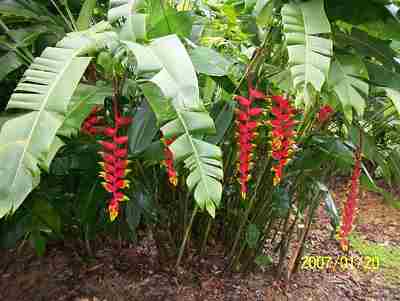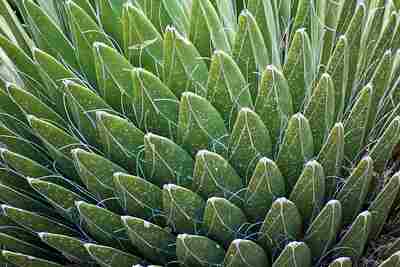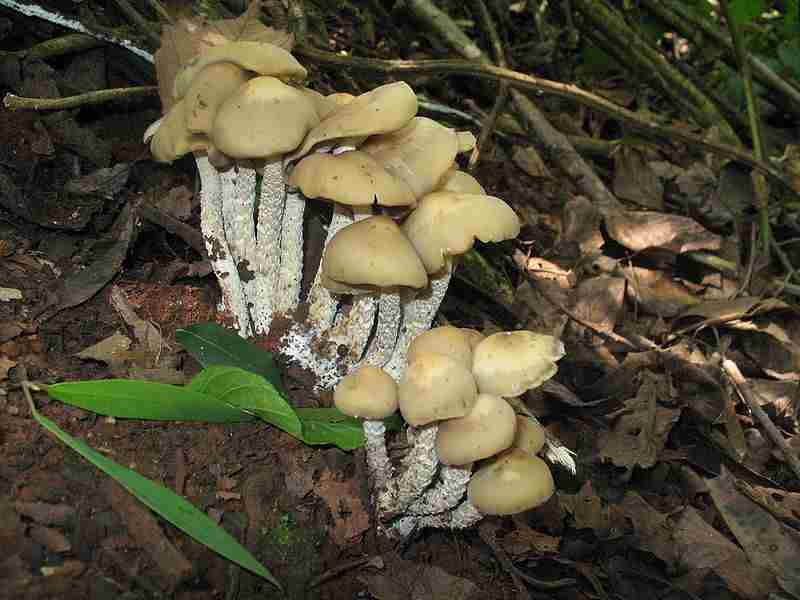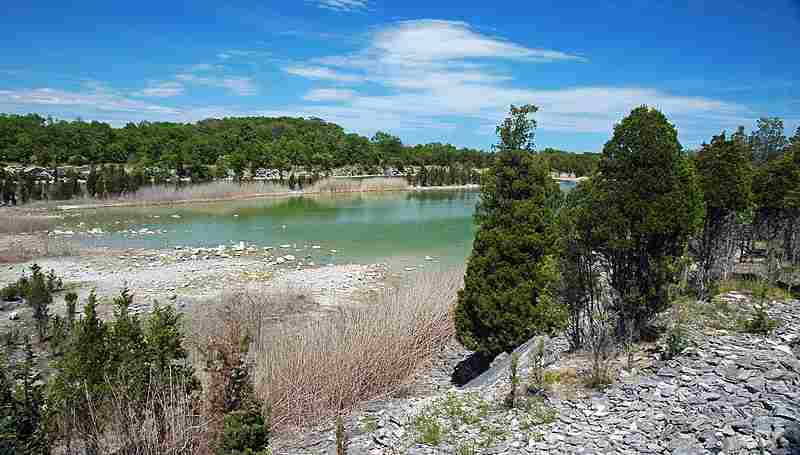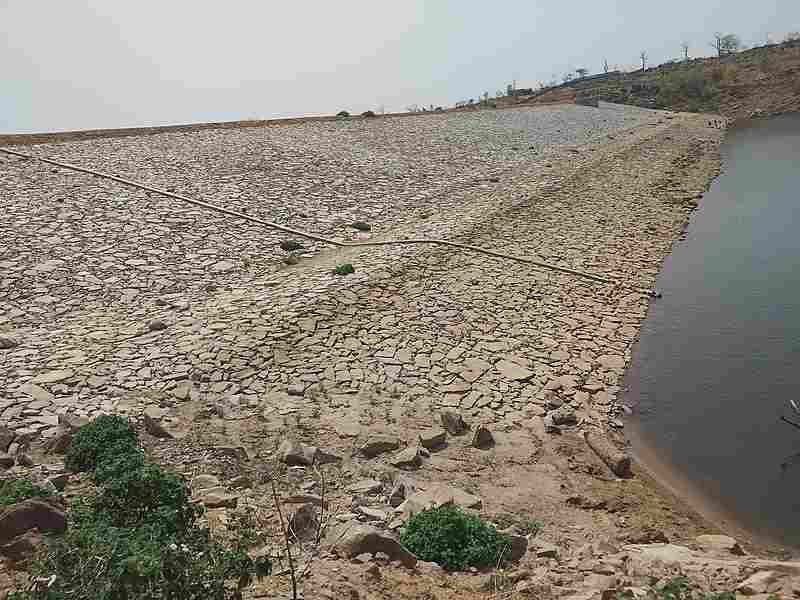Leaves in the Rainforest: Facts, Adaptations, Size, General Function
Leaves in the rainforest ecosystem are large, chlorophyllous, and highly adaptive; and are the key tools for photosynthesis in this biome.
Facts about leaves in the rainforest are; notable morphological variation, evolution for sunlight capture, possession of drip tips, year-round growth, possession of waxy cuticles, competitive growth, poisonous secretions, spiny modification, regional variation in structural details; contribution of carbon storage, relatively high transpiration rates, and soil organic matter contribution.
Adaptations of leaves in the rainforest include; large surface area for light capture, chlorophyllous pigmentation, waxy cuticles, drip tips for water runoff, rapid and continuous growth, spiny features for herbivore deterrence, toxin production, trichomes for pathogen and transpiration control, textural toughness, and efficient nutrient uptake mechanisms.
Reasons why rainforests have large leaves include; to maximize solar capture, for high rates of transpiration, for maximum carbon storage and nutrient cycling.
This article discusses leaves in the rainforest ecosystem in terms of their characteristics, adaptations, and general functions, as outlined below;
Facts About Leaves in the Rainforest
Adaptations of Leaves in the Rainforest
Evaluating the Size of Rainforest Leaves
-Facts About Leaves in the Rainforest
1). There are Notable Variations in Leaf Morphology in Different Layers of the Rainforest
Diverse environmental conditions across different layers of the rainforest contribute to notable variations in leaf morphology.
Factors such as light intensity, nutrient availability, and competition for resources drive adaptive strategies, resulting in distinct leaf shapes, sizes, and structures among plant species inhabiting various strata of the rainforest.
2). Sunlight Capture is the Main Evolutionary Driver of Rainforest Leaves
Sunlight capture serves as the primary evolutionary driver for the morphology of rainforest leaves.
The intense competition for solar energy in the dense canopy has led to the development of diverse leaf adaptations, such as large surface areas, intricate branching patterns, and specific orientations, maximizing the absorption of sunlight for photosynthesis. This evolutionary pressure has shaped rainforest leaves to efficiently harness and utilize the limited sunlight available in the forest ecosystem.
3). Nearly All Rainforest Leaves Have Drip Tips to Prevent Water Collection
Nearly all rainforest leaves feature drip tips, which are specialized structures that prevent water accumulation. This adaptation helps avoid issues such as fungal growth and bacterial infections, ensuring efficient water shedding and minimizing the risk of disease in the humid rainforest environment.
4). Leaves in the Rainforest Experience Growth All Year Round
Leaves in the rainforest exhibit year-round growth due to the consistent and favorable environmental conditions, including ample sunlight and precipitation.
The absence of distinct seasons allows for continuous photosynthesis and the ongoing development of leaves throughout the year.
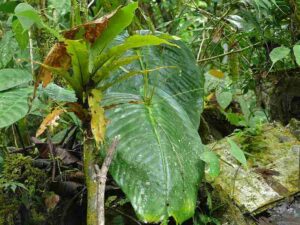
5). Waxy Cuticles in Rainforest Leaves are Thinner than Those of Desert Leaves
Waxy cuticles on rainforest leaves are thinner compared to those of desert leaves. This adaptation reflects the higher humidity levels in the rainforest, where the need for water conservation is less pronounced than in arid environments, leading to a thinner protective layer on the leaf surface.
6). Competition for Light Contributes to the Growth Adaptation of Leaves in the Rainforest
Competition for light is a key factor shaping the growth adaptation of leaves in the rainforest. Intense competition in the densely vegetated environment drives the evolution of features such as large surface areas, unique shapes, and efficient light-capturing structures in leaves, optimizing their ability to access sunlight amidst the dense canopy.
7). Some Leaves in the Rainforest Have Poisonous Secretions to Deter Herbivores
Certain rainforest leaves possess poisonous secretions as an adaptation to deter herbivores.
This defense mechanism helps protect the plants from being consumed by animals, contributing to their survival in the diverse and competitive rainforest ecosystem.
8). Spiny Modification is Another Self Defensive Adaptation of Rainforest Leaves
Spiny modification serves as a self-defensive adaptation of rainforest leaves.
This feature acts as a deterrent against herbivores, enhancing the plant's ability to resist consumption and contribute to its overall defense strategy in the diverse rainforest environment.
9). Details of Leaf Structure Differ from One Tropical Rainforest Location to Another
Leaf structures in tropical rainforests vary between locations.
Differences in factors such as soil composition, climate, and specific ecological niches contribute to the unique adaptations of leaves in different regions, reflecting the rich biodiversity and ecological diversity found across tropical rainforest ecosystems.
10). Leaves Contribute Significantly to the Carbon Storage Function of Rainforests
Leaves play a significant role in the carbon storage function of rainforests. Through photosynthesis, leaves capture and store carbon dioxide, contributing to the forest's crucial role in sequestering carbon and helping mitigate the impact of climate change.
11). Transpiration Rate of Leaves in the Rainforest is Relatively High
Leaves in the rainforest exhibit a relatively high transpiration rate. This is influenced by the consistently humid environment, promoting efficient water uptake and release through leaf surfaces, contributing to the overall hydrological dynamics of the rainforest ecosystem.
12). Rainforest Leaves are the Chief Source of Soil Organic Matter
Rainforest leaves serve as the primary source of soil organic matter.
Their continuous shedding and biodegradation, contribute to the nutrient-rich organic layer on the forest floor, playing a vital role in sustaining the fertility and biodiversity of the rainforest soil.
-Adaptations of Leaves in the Rainforest
1). Large Surface Area for Light Capture
Leaves in the rainforest have a large surface area as an adaptation for effective light capture. This feature optimizes the plant's ability to harness sunlight in the dense canopy environment, supporting efficient photosynthesis and overall growth.
2). Chlorophyllous Pigmentation
Chlorophyllous pigmentation is a crucial adaptation of rainforest leaves.
The presence of chlorophyll, the green pigment responsible for photosynthesis, enables leaves to efficiently capture and convert sunlight into energy, essential for the plant's survival in the rainforest ecosystem.
3). Waxy Cuticles to Minimize Water Absorption and Reflect Light
Waxy cuticles on rainforest leaves serve as an adaptation to minimize water absorption and reflect light.
This feature helps prevent excessive water loss and enhances the leaf's ability to manage light exposure, contributing to the plant's overall adaptation to the humid and competitive rainforest environment.
4). Drip Tips for Water Runoff
Drip tips on rainforest leaves are an adaptation for efficient water runoff.
These specialized tips prevent water from collecting on the leaf surface, reducing the risk of fungal and bacterial growth in the humid rainforest environment and promoting the overall health of the plant.
5). Rapid and Continuous Growth to Survive Competition
Rapid and continuous growth is a crucial adaptation of rainforest leaves to survive intense competition for sunlight.
The need to outcompete neighboring vegetation drives the evolution of leaves that can quickly expand and renew, ensuring efficient light capture in the highly competitive rainforest environment.
6). Spiny Features for Herbivore Deterrence
Spiny features on leaves in the rainforest serve as an adaptation for herbivore deterrence.
These structures act as a defense mechanism, deterring herbivores from feeding on the leaves and providing a means for plants to protect themselves in the competitive and biodiverse rainforest ecosystem.
7). Toxin Production
Toxin production is a key adaptation of rainforest leaves. This defensive mechanism involves the synthesis of toxins, deterring herbivores and contributing to the plant's survival in the highly competitive and diverse rainforest environment.
8). Trichomes for Pathogen and Transpiration Control
Trichomes on rainforest leaves serve as an adaptation for pathogen control and transpiration regulation.
These specialized structures act as a physical barrier against pathogens (by preventing their spread and reproduction on the plant) and help manage water loss through the leaf surface, enhancing the plant's resilience in the humid and challenging rainforest environment.
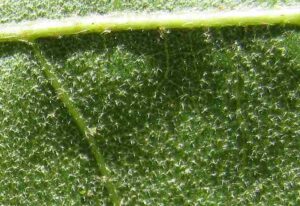
9). Textural Toughness for Ecologic and Mechanical Protection
Textural toughness in rainforest leaves is an adaptation for both ecological and mechanical protection.
This feature provides resilience against environmental challenges and mechanical stress, contributing to the overall survival and defense strategies of plants in the diverse and competitive rainforest ecosystem.
10). Efficient Nutrient Uptake Mechanisms to Survive With Infertile Soil
Efficient nutrient uptake mechanisms in rainforest leaves are adaptations that enable plants to thrive in infertile soils.
These mechanisms, such as specialized root structures and nutrient-absorbing adaptations in leaves, enhance the plant's ability to extract essential nutrients from nutrient-poor soils, contributing to their survival in the challenging rainforest environment.
-Evaluating the Size of Rainforest Leaves
Why Do Rainforests Have Large Leaves?
The three main reasons why rainforests have large leaves are; to maximize solar capture, for high rates of transpiration, and for optimal carbon storage and nutrient cycling. Each of these reasons is discussed briefly below;
1). To Maximize Solar Capture
Rainforest leaves are large to maximize solar capture. The expansive surface area of large leaves enhances the plant's ability to capture sunlight, a crucial factor in photosynthesis.
In the densely vegetated rainforest, where competition for sunlight is intense, large leaves optimize light absorption, providing plants with a competitive advantage in harnessing energy for growth and survival.
2). For High Rates of Transpiration
Rainforest leaves are large to facilitate high rates of transpiration. The substantial surface area of these leaves allows for increased transpiration, the process by which plants release water vapor.
In the humid rainforest environment, efficient transpiration helps regulate temperature, nutrient transport, and water balance within the plant, contributing to its overall health and adaptability in the tropical ecosystem.
3). For Maximum Carbon Storage and Nutrient Cycling
Rainforest leaves are large to maximize carbon storage and nutrient cycling. The expansive surface area of large leaves enables greater photosynthetic activity, leading to increased carbon uptake.
Additionally, the abundant leaf litter generated by large leaves contributes to the recycling of nutrients as it decomposes, enriching the soil and sustaining the intricate web of life in the rainforest ecosystem.
How Big Are the Leaves in the Rainforest?
In the rainforest, leaves exhibit a considerable range in size. Generally, they can vary from a few centimeters to over a meter (3 feet) in length.
This diversity underscores the adaptability of rainforest vegetation, accommodating leaves of various sizes, from less than 1 square millimeter to almost 1 square meter.
Large-leaved plants, such as bananas and palms, contribute to the upper end of this size spectrum, emphasizing the wide-ranging dimensions of leaves in the rainforest ecosystem.
Drip Tip Leaf Adaptation: Characteristics and Functions
Characteristics of drip tips include; distinctive shape, smooth surface texture, associated water-channeling structures, flexibility and size disparity.
Drip tips are often characterized by a pointed or narrowed leaf tip. This shape helps in shedding water efficiently by allowing it to run off the leaf surface.
Many leaves with drip tips have a waxy or smooth surface. This reduces the adhesion of water droplets to the leaf, aiding in their quick runoff.
The leaf margin, or edge, may be designed to channel water toward the drip tip. This can involve a slight curvature or specialized structures that direct water away from the central part of the leaf.
Some plants exhibit flexibility in their leaves, allowing them to bow or fold under the weight of raindrops. This movement assists in the rapid shedding of water.
Drip tips are often more pronounced on larger leaves. Larger leaves have a greater surface area, and shedding water efficiently is crucial to prevent diseases and maintain the structural integrity of the leaf.
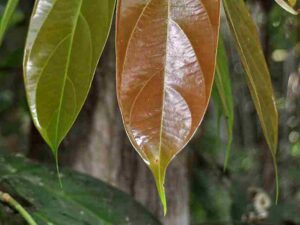
Functions of drip tips are; water runoff, prevention of fungal growth, leaf cleaning, reduced weight stress, optimization of light exposure, and adaptation to high rainfall environments. These are discussed below;
The primary function of drip tips is to facilitate the quick runoff of water from the leaf surface. This prevents water accumulation, which can lead to issues such as fungal and bacterial growth, as well as the development of diseases.
By shedding water efficiently, plants with drip tips reduce the likelihood of fungal growth on the leaf surface. Fungi thrive in moist environments, and the presence of standing water can create conditions conducive to various diseases.
Drip tips help in removing debris, dust, and potential pathogens from the leaf surface. As water runs off, it carries away particles, keeping the leaf clean and promoting better photosynthesis.
In tropical rainforests, heavy rainfall can impose a significant weight on leaves. Drip tips help in shedding water quickly, reducing the stress on the leaf structure and minimizing the risk of damage or breakage.
By preventing water accumulation, drip tips contribute to maintaining an optimal balance of light exposure for photosynthesis. Standing water on leaves can act as a magnifying glass, potentially causing damage to the underlying tissues.
Drip tips are an adaptation to the specific environmental conditions of tropical rainforests, where frequent and intense rainfall is common. Plants with drip tips have evolved to thrive in these environments by efficiently managing water on their surfaces.
Some Plants with Drip Tips in the Rainforest
Drip tips are specialized adaptations found in the leaves of certain plants in rainforests. These adaptations help the plants cope with the abundant rainfall in tropical rainforest environments.
The main function of drip tips is to facilitate water runoff, preventing water from accumulating on the leaf surface and reducing the risk of fungal and bacterial growth.
Some examples of plants with drip tips in the rainforest are; epiphytic orchids, bromeliads, ferns, Bird of Paradise, banana plants, pitcher plants, and heliconias. They are individually discussed below;
1. Epiphytic Orchids (Orchidaceae)
Many orchids in rainforests have drip tips to shed excess water efficiently.
Orchids are often found growing on tree branches, and their drip tips help prevent water accumulation, which could otherwise lead to the growth of fungi.
2. Bromeliads (Bromeliaceae)
Bromeliads are a diverse group of plants that often grow as epiphytes or on the forest floor.
The leaves of many bromeliads have specialized structures, including drip tips, to channel water away and prevent it from collecting in the leaf axils where the plant forms a rosette.
3. Ferns
Various fern species in rainforests have evolved drip tips to cope with the high humidity and frequent rain.
The tips of fern fronds are often pointed or have a narrowing shape, aiding in the shedding of water.
4. Bird of Paradise (Strelitzia spp.)
The leaves of the Bird of Paradise plant often have drip tips. This tropical plant, native to South Africa, is cultivated in many tropical regions and features large, banana-like leaves with a distinct drip-tip shape to shed excess water.
5. Banana Plants (Musaceae)
Banana plants, including the common banana (Musa spp.), have large, broad leaves with drip tips.
This adaptation helps prevent water accumulation on the surface of the leaves, reducing the risk of diseases caused by fungi or bacteria.
6. Pitcher Plants (Nepenthes spp.)
While not all pitcher plant species have drip tips, some do exhibit this adaptation.
Drip tips on the leaves of these carnivorous plants help in shedding rainwater, ensuring that the digestive fluids within the pitcher remain concentrated.
7. Heliconias (Heliconiaceae)
Heliconias are known for their colorful bracts and tropical appearance.
The leaves of heliconias often have drip tips to facilitate water runoff, preventing issues associated with water accumulation, such as rot or disease.
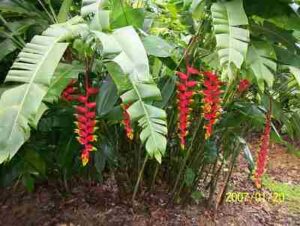
Collectively, these examples highlight the diversity of plants with drip tips in the rainforest. This adaptation is an excellent example of how plants have evolved to thrive in the unique environmental conditions of tropical rainforests.
General Importance of Leaves in the Rainforest
Leaves play a crucial role in the rainforest ecosystem, contributing to the overall health, biodiversity, and functioning of this unique environment.
Some key areas of importance of leaves in the rainforest are; photosynthesis, biodiversity support, nutrient cycling, transpiration and water cycling, adaptations for water management, habitat provision for epiphytes, climate regulation, defense mechanisms, and carbon sequestration.
Below is a discussion of each of these factors;
1. Photosynthesis
Leaves are the primary sites for photosynthesis, the process by which plants convert sunlight into energy. In rainforests, where sunlight is abundant, leaves facilitate the production of organic compounds that form the basis of the food web.
2. Biodiversity Support
The incredible diversity of leaf shapes, sizes, and structures in the rainforest supports a wide variety of plant species.
This diversity, in turn, provides habitats for a multitude of insects, birds, mammals, and other organisms, contributing to the overall biodiversity of the rainforest.
3. Nutrient Cycling
Fallen leaves contribute to nutrient cycling as they decompose on the forest floor.
This process replenishes the soil with essential nutrients, supporting the growth of new plants and maintaining the overall fertility of the rainforest ecosystem.
4. Transpiration and Water Cycling
Leaves play a crucial role in the water cycle through a process called transpiration.
Plants release water vapor through tiny pores called stomata on the surface of their leaves, contributing to the formation of clouds and precipitation, which is vital for the maintenance of the rainforest's water cycle.
5. Adaptations for Water Management
Leaves in the rainforest often have specialized adaptations, such as drip tips, to efficiently manage water in the high-rainfall environment.
These adaptations prevent water accumulation, reduce the risk of diseases, and optimize light exposure for photosynthesis.
6. Habitat for Epiphytes
Many rainforest trees and plants host epiphytes, including mosses, ferns, and orchids, on their leaves and branches.
The structure of leaves provides a substrate for these epiphytes, creating additional microhabitats within the rainforest.
7. Climate Regulation
Leaves contribute to the regulation of microclimates within the rainforest by providing shade and influencing temperature and humidity levels.
This, in turn, creates diverse niches for different plant and animal species to thrive.
8. Defense Mechanisms
Leaves often have various defense mechanisms, including chemical compounds and physical structures, to deter herbivores and pathogens.
These defenses contribute to the resilience of plant species in the face of numerous threats in the rainforest environment.
9. Carbon Sequestration
The large biomass of leaves in rainforests contributes significantly to carbon sequestration, helping mitigate the impacts of climate change by storing carbon dioxide from the atmosphere.
Conclusion
Facts about leaves in the rainforest are;
1. There are Notable Variations in Leaf Morphology in Different Layers of the Rainforest
2. Sunlight Capture is the Main Evolutionary Driver of Rainforest Leaves
3. Nearly All Rainforest Leaves Have Drip Tips to Prevent Water Collection
4. Leaves in the Rainforest Experience Growth All Year Round
5. Waxy Cuticles in Rainforest Leaves are Thinner than Those of Desert Leaves
6. Competition for Light Contributes to the Growth Adaptation of Leaves in the Rainforest
7. Some Leaves in the Rainforest Have Poisonous Secretions to Deter Herbivores
8. Spiny Modification is Another Self Defensive Adaptation of Rainforest Leaves
9. Details of Leaf Structure Differ from One Tropical Rainforest Location to Another
10. Leaves Contribute Significantly to the Carbon Storage Function of Rainforests
11. Transpiration Rate of Leaves in the Rainforest is Relatively High
12. Rainforest Leaves are the Chief Source of Soil Organic Matter
Adaptations of leaves in the rainforest include;
1. Large Surface Area for Light Capture
2. Chlorophyllous Pigmentation
3. Waxy Cuticles to Minimize Water Absorption and Reflect Light
4. Drip Tips for Water Runoff
5. Rapid and Continuous Growth to Survive Competition
6. Spiny Features for Herbivore Deterrence
7. Toxin Production
8. Trichomes for Pathogen and Transpiration Control
9. Textural Toughness for Ecologic and Mechanical Protection
10. Efficient Nutrient Uptake Mechanisms to Survive With Infertile Soil
Reasons why rainforests have large leaves include;
1. To Maximize Solar Capture
2. For High Rates of Transpiration
3. For Maximum Carbon Storage and Nutrient Cycling
